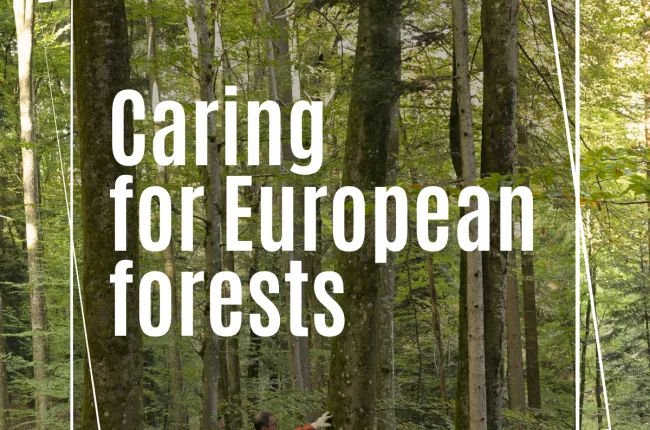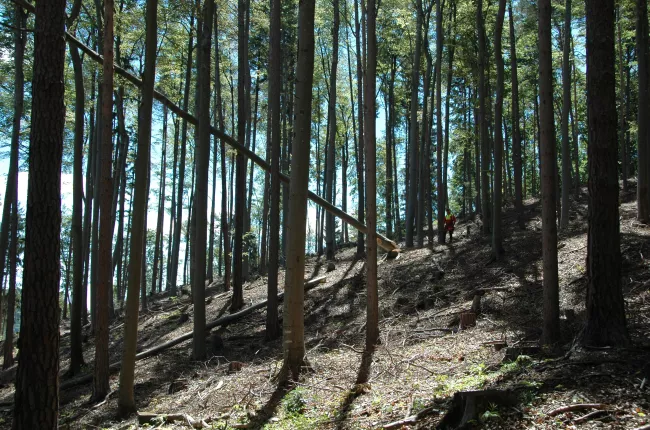Background
On 30 June 2023, Copa-Cogeca, CEPF, EUSTAFOR and CEJA organized a joint seminar on ‘Bioeconomy and Sustainable use of natural resources: from niche to norm 4S – Sustainability, speed, scale and skills’ with a view to strengthening the bioeconomy in the upcoming EU political cycle starting in 2024 and enhancing the bio-based sectors’ contribution to the sustainable transition of the European Union. The wide audience and speakers from all walks of the EU bioeconomy sectors from forestry, agriculture, the European Commission, European Parliament, FAO, academia and stakeholder organisations gathered under the common goal to increase the political impetus for Bioeconomy.
This event generated recommendations from primary producers in the EU regarding the future of the EU's bioeconomy policy framework. Aligning the goal of the Joint Seminar, these Recommendations aim to support and inspire discussions among policy makers, legislators and stakeholders in a pursuit to create a dedicated and enabling policy environment in the upcoming EU political cycle, where EU bioeconomy can contribute and develop to its full potential.
Forestry and agriculture, as the EU’s primary producing sectors and suppliers of bio-based raw materials have the core interest to play key roles in this journey and provide steady supply of sustainably sourced renewable bio-based materials for the European economy. Primary producers are convinced that this journey is only possible with a robust EU R&I framework, strong involvement of young generations in forestry and farming and a coherent EU policy environment.
Introduction
The bioeconomy is of central importance in combatting climate change and safeguarding ecosystem resilience. It recognises the full value of ecosystem services, promotes economic development and creates new jobs, especially in rural and remote areas of Europe. The use of sustainable biomass from agriculture and forestry enables the two concepts of bio- and circular economy to interconnect within a bio-based circular economy by providing renewable materials, services and products that can be used, reused and recycled up until the end of their life, at which point they can be turned into energy.
Recommendations of EU primary producers for the next steps on the EU bioeconomy policy framework
A new impetus for the EU bioeconomy based on the AGRIFISH Council Conclusions of April 20231
- The bioeconomy should be high on the political agenda for the next European Parliament and Commission and a priority at national and regional level. A revision of the Bioeconomy Strategy is needed to address the challenges and opportunities that come with fully integrating the bioeconomy into rural areas and ensuring their fullest potential is unleashed in this regard. In light of the current challenges, a more coherent policy approach under a new EU Bioeconomy Strategy should be considered;
- The bioeconomy should be considered as a long-term solution to climate challenges and be supported by long-term policies to attract young people into rural areas, promote the development of new skills and implement innovative solutions for a sustainable supply and use of locally-sourced biomass;
- The bioeconomy and its funding mechanisms should be a priority not only for the CAP but also for other key EU policies such as climate, biodiversity, cohesion, skills etc. This will help increase policy coherence and efficiency, leading to an integrated bioeconomy across different sectors;
- There is a need for strong policy coordination at EU and national level among various sector-related governance bodies (e.g., agriculture, forestry, biodiversity, climate, energy, waste). This should improve the flow of materials and residues within and between different industries and users in order to allow for a more efficient use of available biomass resources. This coordination needs to extend to beyond the EU to ensure a just transition for the other countries supplying biomass;
- The bioeconomy is a key solution to ensuring the transition towards low fossil carbon economies, but it does not come without risk. Risks can be avoided by anticipating and effectively managing them, which is crucial if we want the EU to be a front runner and to ensure that the agriculture and forestry sectors remain competitive and contribute to viable rural areas;
- Engage primary producers in the whole policymaking process. In order for farmers, forest owners and managers to enhance their contribution to a more sustainable bioeconomy and to healthy and resilient ecosystems, they need to be considered equal partners rather than mere biomass suppliers;
- Build on producers’ cooperatives as key stakeholder entities implementing concrete actions to further develop the rural bioeconomy in the EU. They are exemplary, sharing the added value with their members, increasing the sector’s economic resilience and retaining the economic value in rural areas. It is essential to further develop and promote such cooperative models;
- The EU should support a bioeconomy that capitalises on the huge diversity of its supply chains specific to each EU region. A diversified EU bioeconomy will be more resilient to changes in feedstock supply, market dynamics and technologies as well as able to contribute more to job creation and the provision of services by forest and agro-ecosystems
- Cross-border knowledge networks should be developed through the promotion of joint research opportunities funded by EU programmes such as Horizon Europe, with a focus on application on the ground;
- The gap between Member States’ actions for agriculture and forestry bioeconomies should be better addressed and the countries/regions that are lagging behind should be better supported. This can be achieved through the exchange and transfer of knowledge and by joining forces in research and innovation projects closely linked to practice and scaling them up;
- Collaboration between public-private partnerships could help turn niche into norm to sup-port the development and implementation of bioeconomy initiatives. Moving from nicheto norm needs strong public-private partnerships in which rural actors actively participate.Collaboration between public and private sectors is necessary;
New skills, education and knowledge exchange on national and Union level to enhance the EU bioeconomy
- The skills and knowledge gaps related to the bioeconomy should be identified and required skills should be further aligned with those set out in the economic, social and environmental pillars of sustainability;
- More work at EU and national level should be done to bridge the gap between science and practice by developing practice-based knowledge and looking at the cost-effectiveness of solutions proposed on the ground;
- Educational pathways in agriculture and forestry for students should be diversified to seize the opportunities of the bioeconomy and gain the right skill set, e.g., through the creation of dedicated curricula in schools and universities;
- Take advantage of peer-to-peer learning by promoting the establishment and reinforcement of knowledge exchange networks on bioeconomy, collaborating with the different actors involved;
- Facilitate the involvement of underrepresented populations, in particular women, young people and migrants, starting with policymaking discussions through cooperatives, producer organisations and representative organisations;
- Develop intergenerational cooperation, taking advantage of the innovative and transformative mindset of new generations and combining it with the experience of older generations;
- Communicate more intensively on the professional opportunities offered by the bioeconomy, including a more positive promotion of agriculture and forestry and capacity-building in communication by those directly involved with bioeconomy at territorial level;
- Improve the interface between policy, science and practice by sharing knowledge at all levels of decision-making
How to scale up the transition toward a circular EU bioeconomy?
- The knowledge and motivation to change are present, but a market incentive is missing to upscale the bioeconomy in the EU. The EU and Member States need to stimulate the bioeconomy and ensure the financial resources for forest owners and managers, farmers and their cooperatives to invest more in circular value chains;
- Invest in and build up an EU network as well as national networks of young innovators and experts and stimulate their participation in the bioeconomy sectors;
- More effort is required to close the gap between farmers, foresters and the EU policy makers to make them understand the legislation and get them on board with the transition;
- The design of projects must grant special consideration to territorial scope (EU, national, regional or local);
- In new products, the focus should be more on renewability and not just recyclability as both are crucial elements for environmental sustainability. It is also important to recognise that there is not always a benchmark for comparison especially with new innovations;
- Appoint in the next EU Commission President’s cabinet a bioeconomy coordinator with a focus on policy coordination or, at least, a dedicated cabinet member for each bioeconomy-relevant Commissioner (GROW,CLIMA, ENV, REGIO, AGRI, RTD).
Bioeconomy as the enabler of the sustainable use of natural resources
- Design policies through the lens of viewing the bioeconomy as a vehicle in the transition to a sustainable and circular use of natural resources;
- The environmental sustainability of the bioeconomy needs to be better quantified and communicated and its contribution to key EU objectives recognised. There needs to be more awareness of the positive impact of bioeconomy initiatives and their alignment with sustainability goals;
- Give due regard to the great interest from young farmers in recycling and upcycling bio-based waste and by-product and integrating the bioeconomy and its interdisciplinary concept into future agricultural, forest and environmental policies to enhance generational;
- Regard farms and forests as a whole ecosystem in which trade-offs are addressed between different functions. Policy framework should provide the best advice and assess these trade-offs and their impacts;
- Capitalise on the bioeconomy’s potential to develop European rural economies with regard to all the three pillars of sustainability, within planetary boundaries and without exerting pressure on ecosystems;
- A paradigm shift around the bioeconomy shall be a major tool in having the economy transition away from fossil fuels as opposed to decarbonising it. Anchor economic policies around the potential of the bioeconomy as a provider of non-fossil materials;
- Take young farmers’ and forest owners’ generation into account to a greater extent in policy making to facilitate the bioeconomy’s move from niche to norm;
- Today, neither the bioeconomy nor the fossil-based economy can sustain the EU economy on its own, however a steady shift towards the bioeconomy can be possible with developments meeting specific standards;
- The EU and its member countries should play a key role to also support other regions in their efforts to transition to a sustainable bioeconomy. The EU should increase cooperation with its global partners whose bioeconomy is advanced.
_________________________________________
1 https://data.consilium.europa.eu/doc/document/ST-8194-2023-INIT/en/pdf




